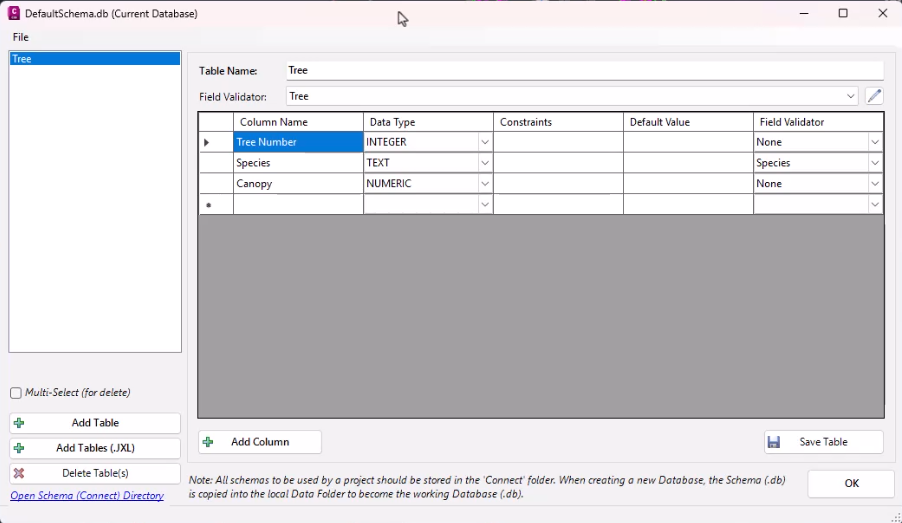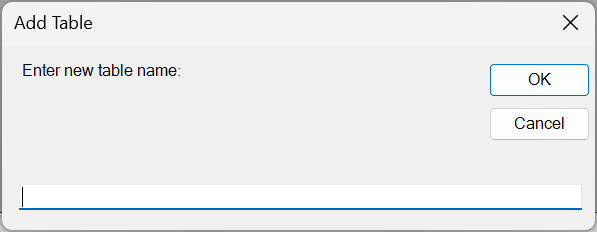Schema Editor
Icon: |
|
Introduction
This command allows to create and manage Schemas that define the structure and data fields used to store attribute information for survey strings and points.
It also allows adding, modifying, or removing attribute fields, assigning default values, and saving schema configurations that will be applied during attribute assignment.
Note: When you select New Schema, the schema is not saved until you add a table and use Save Table. Without these steps, the schema will not be created.
Schema Structure
The Schema defines how data is organised within the relational database; this is inclusive of logical constraints such as, Data Table names, fields, data types and the relationships between these entities.
A Schema is considered the “blueprint” of a database which describes how the data may relate to other tables or other data models. However, the schema does not actually contain data.
A Schema can be applied to a local database containing COGO Points and Survey Strings and provides the structure for storing and managing the data.
Schema Storage Types
The Schema Editor manages both Schemas used to create new Project Databases, as well as Schemas being used in a local project. Understanding the difference helps ensure consistent project setup and editing workflows.
| Global Schema (Schema Template) | A relational database stored in the CSA Settings Folder. Used when creating a new Project Database, and to append Schemas to a Project Database. |
| Local Schema | A project-specific schema stored in the .db file in the project’s Data folder (stored in the Project Database), managing the structure and relationship between data applied to objects. |
When using this form, this Globlal/Local status will be identified in the form title.
- Global Schemas will be described with the full path to the Schema including the Schema file name and type
- Local Schemas will be described with the name of the Schema contained within the current database and the the words "Current Template".
Schema Summary Table
| Type | Stored In | Scope |
|---|---|---|
| Global Schema | CSA Settings Folder | Provides the "blueprint" of a relational database |
| Local Schema | Project's Data folder (.db) |
Provides the data structure for data stored in a local drawing/project |
About Field Validation
Allowable inputs can be set for any Field in a Data Table by applying a Validated List to the field. Validated lists are managed via the Field Validator. The Field Validator allows the user to create a list of Field names. For each named field, the user can add the allowable inputs in a list, as well as determine whether a blank field input is acceptable.
It is important to ensure that the Field Name used in the Field Validator form matches the Field Name contained in the Data Table where the validated list is being applied - if the names do not match, the list will not be applied to control the field inputs.
Data that has been added and does not match allowable inputs as per the validated list will be highlighted to users while editing the object/s.
The Field Validator is stored external to individual projects and can be applied to any Schema (global or local) at any time.
Details
Upon selecting the command the following form is displayed:
|
|
|||||||||||||||
|
File menu |
The File menu contains options like New Schema, Open Schema, Save Table, and others | ||||||||||||||
|
|||||||||||||||
|
Data Tables Management |
Lists created Data tables for management and editing | ||||||||||||||
|
[Data Table Listing] |
Lists all created Data Tables. Select one for editing. | ||||||||||||||
|
Multi Select (for delete) tick box |
Toggle on to enable multi delete. When ticked on, multiple Data Tables can be selected. Pressing the Delete button on the keyboard will remove the highlighted Data Table/s | ||||||||||||||
|
Add Table |
Adds a new Data Table
|
||||||||||||||
|
Add Tables (JXL) |
Imports one or more attribute tables from a Trimble JXL file. Navigate to and select the JXL file to create all attribute tables contained in the .jxl. | ||||||||||||||
|
Delete Table(s) |
Removes selected Data Tables from the current Schema | ||||||||||||||
|
Data Table Editing |
Edit the selected Data Table | ||||||||||||||
|
Table Name |
Name of the Data Table. This is an editable field. | ||||||||||||||
|
Field Validator |
Select a Field Validator that can be applied to the Data Table. Managing allowable lists of inputs is managed from the Field Validator form. | ||||||||||||||
|
Edit Field Validation Lists |
Opens the Field Validator form. | ||||||||||||||
|
[Data Table List] |
Lists the input of Fields within the selected Data
Table
|
||||||||||||||
|
Add Column |
Add a new Attribute Field to the Data Table | ||||||||||||||
|
Save Tabe |
Click to save the current Data Table | ||||||||||||||
|
OK |
Commits all edits to the Schema, including added/removed fields, names, types, and constraints. | ||||||||||||||

